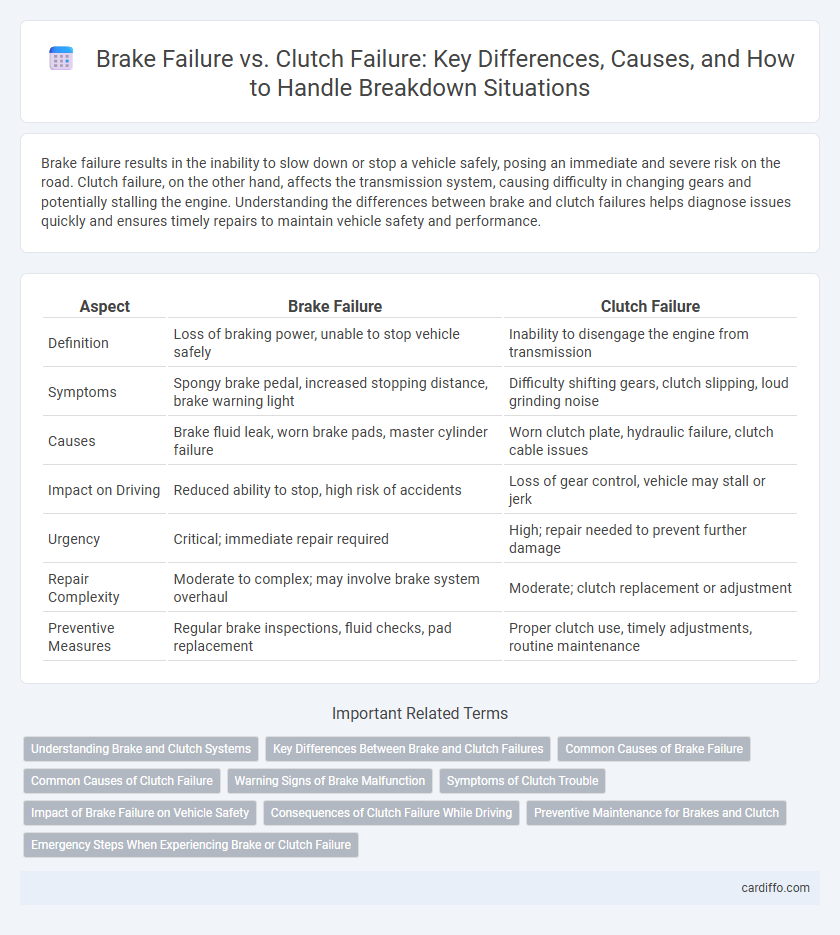Brake failure results in the inability to slow down or stop a vehicle safely, posing an immediate and severe risk on the road. Clutch failure, on the other hand, affects the transmission system, causing difficulty in changing gears and potentially stalling the engine. Understanding the differences between brake and clutch failures helps diagnose issues quickly and ensures timely repairs to maintain vehicle safety and performance.
Table of Comparison
| Aspect | Brake Failure | Clutch Failure |
|---|---|---|
| Definition | Loss of braking power, unable to stop vehicle safely | Inability to disengage the engine from transmission |
| Symptoms | Spongy brake pedal, increased stopping distance, brake warning light | Difficulty shifting gears, clutch slipping, loud grinding noise |
| Causes | Brake fluid leak, worn brake pads, master cylinder failure | Worn clutch plate, hydraulic failure, clutch cable issues |
| Impact on Driving | Reduced ability to stop, high risk of accidents | Loss of gear control, vehicle may stall or jerk |
| Urgency | Critical; immediate repair required | High; repair needed to prevent further damage |
| Repair Complexity | Moderate to complex; may involve brake system overhaul | Moderate; clutch replacement or adjustment |
| Preventive Measures | Regular brake inspections, fluid checks, pad replacement | Proper clutch use, timely adjustments, routine maintenance |
Understanding Brake and Clutch Systems
Brake failure occurs when the hydraulic or mechanical components responsible for stopping a vehicle lose efficiency, leading to reduced or complete loss of braking power. Clutch failure involves the inability of the clutch system to engage or disengage the engine from the transmission, often caused by worn friction material or hydraulic issues. Understanding the brake system's reliance on fluid pressure and the clutch system's dependence on friction plates is crucial for diagnosing and preventing these critical breakdowns.
Key Differences Between Brake and Clutch Failures
Brake failure primarily affects vehicle stopping power, causing dangerous inability to decelerate or halt, while clutch failure disrupts power transmission between the engine and wheels, leading to gear shifting issues. Brake failure symptoms include spongy brake pedal, unusual noises, and increased stopping distance, whereas clutch failure presents slipping, difficulty in engaging gears, and burning smell. Understanding these key differences is critical for timely diagnosis and effective repair, ensuring vehicle safety and performance.
Common Causes of Brake Failure
Brake failure commonly results from worn brake pads, fluid leaks, or air in the brake lines, leading to reduced braking efficiency and increased stopping distances. Contaminated or low brake fluid degrades hydraulic pressure, causing brakes to feel spongy or fail entirely. Regular maintenance and inspection of brake components are critical to prevent catastrophic brake system failures on the road.
Common Causes of Clutch Failure
Clutch failure often results from worn clutch plates, oil contamination, or improper use, such as riding the clutch or frequent aggressive shifting. Heat buildup due to excessive slipping or hydraulic system leaks can also damage the clutch components, leading to breakdowns. Understanding these causes helps differentiate clutch failure from brake failure, which typically involves worn brake pads or fluid leaks.
Warning Signs of Brake Malfunction
Brake malfunction warning signs include a spongy or soft brake pedal, unusual grinding or squealing noises, and increased stopping distances, indicating potential brake fluid leaks or worn brake pads. Brake warning lights on the dashboard and vibrations during braking also signal possible brake system failure. Early detection of these symptoms is crucial for maintaining vehicle safety and preventing accidents.
Symptoms of Clutch Trouble
Clutch trouble symptoms include difficulty shifting gears, a burning smell, and a spongy or sticking clutch pedal. Drivers may experience slipping, where the engine revs increase without corresponding acceleration, indicating clutch plate wear. Early detection of these signs prevents complete clutch failure and costly repairs.
Impact of Brake Failure on Vehicle Safety
Brake failure significantly compromises vehicle safety by drastically reducing the driver's ability to slow down or stop, increasing the risk of collisions and severe accidents. Unlike clutch failure, which mainly affects gear shifting and drivability, brake failure directly endangers passengers, pedestrians, and other road users by impairing critical stopping functions. Timely maintenance and regular brake system inspections are crucial to preventing brake failure and ensuring overall road safety.
Consequences of Clutch Failure While Driving
Clutch failure while driving can lead to an immediate loss of power transmission between the engine and wheels, causing the vehicle to stall unexpectedly and increasing the risk of accidents. Unlike brake failure, which affects stopping ability, clutch failure disrupts gear engagement, resulting in difficulty shifting or complete inability to change gears. This malfunction often forces drivers to stop abruptly or coast uncontrollably, compromising vehicle control and safety on the road.
Preventive Maintenance for Brakes and Clutch
Brake failure and clutch failure pose significant safety risks and require distinct preventive maintenance approaches for optimal vehicle performance. Regular inspection of brake pads, fluid levels, and hydraulic lines prevents brake system malfunctions, while timely clutch cable adjustments, fluid replacements, and monitoring for wear ensure clutch reliability. Implementing a manufacturer-recommended maintenance schedule enhances the longevity of both systems, reducing the likelihood of unexpected breakdowns.
Emergency Steps When Experiencing Brake or Clutch Failure
In the event of brake failure, immediately pump the brake pedal to build pressure and engage the emergency brake gradually while shifting to lower gears to reduce speed. For clutch failure, avoid forcing the clutch pedal and use engine braking by downshifting to slow the vehicle safely. Steering carefully to the roadside and activating hazard lights are crucial emergency steps in both situations to alert other drivers and prevent accidents.
Brake Failure vs Clutch Failure Infographic

 cardiffo.com
cardiffo.com